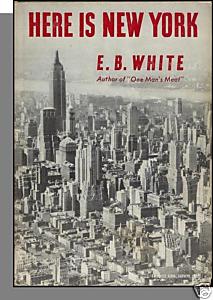One writer claims that "there is no more quoted piece of prose" than E. B. White's essay "This is New York". Before the famous author wrote Charlotte's Web and Stuart Little, he penned an essay for Holiday magazine. It is the perfect example of an essay filled with the elements of fiction, including foreshadowing. Who would have thought that he would predict 9/11?
"New York is to the nation what the white church spire is to the village," explained White, commenting on how New York was filling with skyscrapers. Early in the essay, White maps out his location by explaining how many blocks he is away from certain events in history: Rudolph Valentino laying in state, Nathan Hale's execution, Ernest Hemingway punching Max Eastman, Walt Whitman writing editorials and Marceline clowning on the boards at the Hippodrome. History is on every corner of New York City.
When White went downstairs to eat at the cafe, he found himself sitting eighteen inches away from Fred Stone, star of the Wizard of Oz. "The eighteen inches were both the connection and the separation that New York provides for its inhabitants." He uses the eighteen inches analogy to highlight the proximity of everything and everyone in New York.
White points out that since he's arrived in town, a number of "splashy events" have occurred, almost unnoticed: a man killed his wife in a jealous rage; the world's two largest ocean liners arrived and departed; the greatest air show on earth took place. It's all part of a normal day in the city.
"New York is peculiarly constructed to absorb almost anything that comes along," observed White. The author says there are three types of New Yorkers: the native, who gives the city solidarity, the immigrant, who gives the city passion, and the commuter, who gives the city restlessness. On any given day, you might have a farmer arriving from Italy to set up a grocery store, a girl from Mississippi trying to escape her small town and a man with a manuscript from the Corn Belt (the latter could describe Theodore Geisel who did just that in 1957, later called Dr. Seuss).
White points out those who have moved up in the world in New York: Irving Berlin's journey from Cherry Street to the East Side. He reminds us that New York "reached it highest point in the sky at the lowest moment of the Depression". Irving Berlin was one of the city's 2 million Jewish residents; at the time it also had 700,000 Blacks, half a million Irish and half a million Germans, along with 230,000 Puerto Ricans. "In New York Smolders every race problem there is but the noticeable thing is not the problem but the inviolate truce." How fitting that the United Nations would be built in such a city.
White describes how New York is a big city full of small neighbourhoods. Within two or three blocks its residents could find a grocer, barber, newsstand, dry cleaner, deli, flower shop, etc. They could spend a lifetim in an area smaller than a country village.
E. B. White concludes by saying that New York is both "changing and changeless". He focusses on the willow tree in the East River: despite the abuse that it takes, it keeps growing upward.

No comments:
Post a Comment